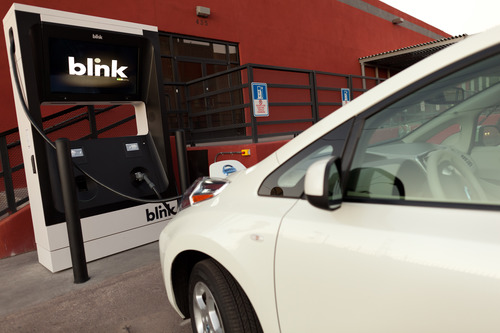I’ve recently written a few blog posts about the Blink Network and its problems. The other day I posted a not-so-well-thought-out survey of questions about Blink, and other charging networks. The results weren’t very conclusive because of the small number of responses, but did agree with the widely held belief that Blink is not a good charging network. What’s bringing me back to my keyboard is a piece in The New Yorker![]() which is both deeply flawed, and contains some nuggets of a ray of hope for the future of the Blink Network.
which is both deeply flawed, and contains some nuggets of a ray of hope for the future of the Blink Network.
Maybe, just maybe, Blink will become useful.
The article features a discussion with Michael Farkas, CEO of the CarCharging Group. CCG became the parent of the Blink Network about a year ago, after ECOTality’s bankruptcy. In the piece Farkas describes that as a mouse swallowing an elephant – clearly meant for us to feel sympathy for the task CCG has in front of itself. For CCG to make something useful out of purchasing the Blink Network, they have to rehabilitate that network, fix the flaws which made it so unreliable over the years, etc.
Earlier this month CCG changed the Blink fee structure, but the customer base is revolting at the resulting drastic cost increase.
The New Yorker piece purports to be going over Blinks problems with the CEO in charge. But not a smidgeon of a mention is made of how angry Blink members are at the new fee structure.
Instead it focuses on other problems – problems that essentially every Blink user will recite verbatim. Charging stations that are frequently down, the Blink app doesn’t reliably show charging station status, and the fact that Blink had to turn down the charging rate on their charging stations.
Farkas’ explanation of why the charging rate was turned down is plain wrong. He is reported to have said that Blink ended up with “bad cords” on their charging stations, and supposedly it wasn’t immediately clear who might be making high-quality cords.
I’m sorry, but that’s flat out wrong. In Feb. 2013 there were reports of Honda Fit EV and Toyota RAV4 EV owners whose charge ports were overheating, melting even, when connected to Blink charging stations. Learning of it, I did some field research, going over to a nearby Blink station and turning the charging rate up a little bit higher than I should. At a 35 amp charging rate the charging connector did get a bit hot. But it didn’t seem to be hot enough to cause any damage.
What I learned that day is the charging connectors on the Blink charging station were only rated for 30 amps. Blink had set the charging stations so they’d run at around 30 amps. The rule is that for “continuous use” (like electric car charging), you’re supposed to limit it to 80% of the rated rate. That would make 24 amps the correct maximum charging rate through cords rated for 30 amps.
(Yes, that’s an electric Karmann Ghia![]() )
)
Some time after the controversy Blink did indeed decrease the charging rate to 24 amps. But it wasn’t because Blink accidentally ended up with “bad cords”. ECOTality/Blink made two major mistakes:
Choosing cords rated for only 30 amps
Running cords rated for 30 amps at over 30 amps
ECOTality/Blink could have used cords rated for higher power levels, and they could have set the charging stations to the correct charging rate. They didn’t and that’s entirely their fault.
The good news is there’s a “major overhaul” due in “mid-October.” One that will replace all the charging cords, allowing Blink to turn the charging rate back up. They might fix some other problems as well – such as vandalism, network connectivity problems, etc.
CCG’s purchase of the Blink network gave CCG a huge charging station footprint. The “mouse swallowing an elephant” analogy is on the mark. But, by making this purchase, CCG bought themselves a major role in the electric car charging business. It is important for the rest of us that CCG fill that role with honor and distinction. We need there to be more than one charging station company of significance.
This market is too important to be left to ChargePoint alone. CP needs a significant competitor. CCG bought themselves that role.
- Highway design could decrease death and injury risk, if “we” chose smarter designs - March 28, 2015
- GM really did trademark “range anxiety”, only later to abandon that mark - March 25, 2015
- US Government releases new regulations on hydraulic fracturing, that some call “toothless” - March 20, 2015
- Tesla Motors magic pill to solve range anxiety doesn’t quite instill range confidence - March 19, 2015
- Update on Galena IL oil train – 21 cars involved, which were the supposedly safer CP1232 design - March 7, 2015
- Another oil bomb train – why are they shipping crude oil by train? – Symptoms of fossil fuel addiction - March 6, 2015
- Chevron relinquishes fracking in Romania, as part of broader pull-out from Eastern European fracking operations - February 22, 2015
- Answer anti- electric car articles with truth and pride – truth outshines all distortions - February 19, 2015
- Apple taking big risk on developing a car? Please, Apple, don’t go there! - February 16, 2015
- Toyota, Nissan, Honda working on Japanese fuel cell infrastructure for Japanese government - February 12, 2015


















